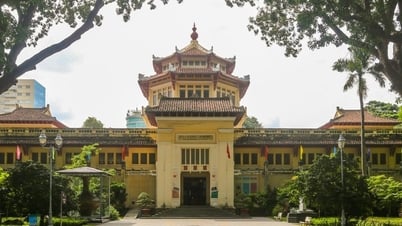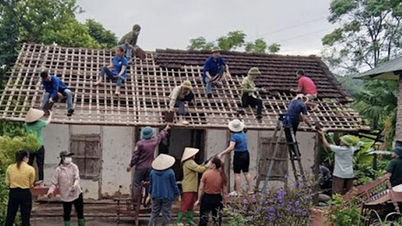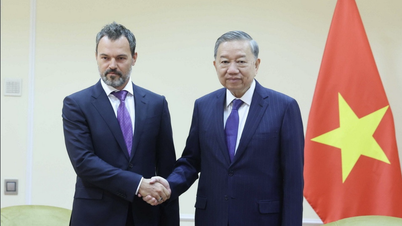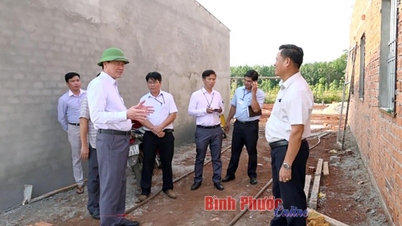
Illustration
One of the notable contents is the orientation of the plan for arranging cadres, civil servants and public employees when implementing the organization of two-level local government.
Accordingly, the arrangement and assignment of cadres and civil servants to hold leadership and management positions of provincial-level administrative units (DVHC) after the arrangement shall be implemented according to the Conclusion of the Politburo and the guidance of the Central Organizing Committee for provincial levels subject to consolidation and merger.
The number of leaders and managers of agencies and organizations in the new provincial-level administrative unit after the arrangement must not exceed the total number of leaders and managers present in the agencies and organizations in the provincial-level administrative unit before the arrangement and the arrangement must be carried out according to the instructions of the competent authority.
For those holding the position of head of a professional agency, based on practical conditions and standards, capacity of cadres and civil servants, the Standing Committee and the Provincial People's Committee shall consider and decide to select a head who meets the requirements of the new unit's tasks after the arrangement.
For the head of a specialized agency who is not assigned to continue to be the head after the arrangement, he/she will be arranged to an adjacent subordinate position or arranged to hold an equivalent position in another agency, organization or unit or promoted to become a commune-level leader according to the requirements of the tasks and capacity of the cadres and civil servants and will have his/her position allowance reserved according to the Government's regulations on the arrangement of the organizational apparatus.
For those holding the position of deputy head of a professional agency, the Standing Committee and the Provincial People's Committee shall consider and decide to arrange them to be deputy head of the unit after the arrangement or arrange them to hold an equivalent position in another agency, organization or unit or to strengthen them to be leaders at the commune level according to the requirements of the tasks and capacity of the cadres and civil servants.
In the immediate future, the number of deputy heads of agencies, organizations and units under local government in the new provincial-level administrative unit after the arrangement may be higher than the regulations and gradually decrease according to the roadmap to ensure implementation of the Government's regulations.
For civil servants, public employees, and contract workers as prescribed, initially maintain the current number of civil servants, public employees, and contract workers at the agency, organization, or unit to arrange and assign work at the corresponding agency, organization, or unit or assign work at the commune level. Then, streamline the payroll in conjunction with restructuring and improving the quality of the team according to the roadmap, ensuring that within 5 years, the number of payrolls is basically implemented in accordance with regulations.
Orientation of arrangement and assignment of cadres, civil servants and public employees at commune level
The document also clearly states that the standards for commune-level leadership and management positions and titles are the same as those for corresponding district-level leadership and management positions and titles according to current regulations of the Government.
For civil servants and professional and technical officials at the commune level, the training level standards according to job position requirements for civil servants and officials from district level and above shall be applied according to Government regulations.
Based on practical conditions and standards, capacity of cadres, civil servants and public employees at district level and cadres and civil servants at commune level, the Standing Committee and the Provincial People's Committee shall consider and decide on the arrangement and assignment of cadres, civil servants and public employees at the new commune level according to the management hierarchy.
District and commune-level cadres, civil servants and public employees, when assigned to leadership and management positions at new commune-level administrative units, shall continue to receive their current leadership position allowance for a period of 6 months from the date of the decision; thereafter, they shall comply with the new regulations of the Government.
In case civil servants and professional and technical officials are appointed to leadership and management positions at new commune-level administrative units, the leadership position allowance level will not be applied temporarily and will be implemented when there are Government regulations on the coefficient of allowances for such leadership and management positions.
Cadres, civil servants, public employees, and workers receiving salaries from the state budget, when assigned to work at new administrative units, will continue to receive salaries according to their current ranks, grades, and salary allowances for a period of 6 months; after that, they will be implemented according to new regulations of the Government.
In case cadres, civil servants, public employees, and workers during the arrangement process submit a voluntary application for early retirement or resignation, the competent agency, organization, or unit shall review, evaluate, and implement policies and regimes according to current regulations of the Government, ensuring the retention of people with outstanding abilities who meet the requirements of the task.
In case officials and civil servants at district and commune levels do not meet the standards and conditions to be assigned to a new position at the commune level, the regime and policies will be resolved according to current regulations of the Government.
Cadres, civil servants, public employees, workers, and salary earners in the armed forces in the administrative unit area after the rearrangement continue to enjoy the special regimes and policies applied by region, area, or administrative unit as before the rearrangement until there is another decision by the competent authority. In case of change in the name of the administrative unit after the rearrangement, the new name of the administrative unit shall be used to continue to organize the implementation of special regimes and policies.
The provincial-level local government where the new administrative headquarters of the new administrative unit is expected to be located after the rearrangement is responsible for proactively balancing and allocating the budget to invest in repairing, renovating and upgrading the working headquarters that will continue to be used to serve the operations of the administrative unit after the rearrangement; paying attention to official housing, means of work and travel needs for the team of cadres, civil servants, public employees and workers to stabilize working conditions at the new administrative unit after the rearrangement.
When implementing the arrangement of provincial-level administrative units, localities, based on the conditions of information technology infrastructure and digital transformation in the operation of the government apparatus, can arrange a reasonable proportion of cadres, civil servants and public employees working simultaneously at the administrative headquarters of the merged province and at the administrative - political center of the new administrative unit to ensure state management work in the localities of the merged province and reduce difficulties in travel and living of cadres, civil servants, public employees and workers in the initial stage of the merger.
Thu Giang
Source: https://baochinhphu.vn/dinh-huong-phuong-an-sap-xep-can-bo-cong-chuc-vien-chuc-khi-thuc-hien-to-chuc-chinh-quyen-dia-phuong-2-cap-102250416105646694.htm



![[Photo] General Secretary To Lam concludes visit to Russia, departs for Belarus](https://vphoto.vietnam.vn/thumb/1200x675/vietnam/resource/IMAGE/2025/5/11/0acf1081a95e4b1d9886c67fdafd95ed)
![[Photo] General Secretary To Lam arrives in Minsk, begins state visit to Belarus](https://vphoto.vietnam.vn/thumb/1200x675/vietnam/resource/IMAGE/2025/5/11/76602f587468437f8b5b7104495f444d)

![[Photo] General Secretary To Lam meets and expresses gratitude to Vietnam's Belarusian friends](https://vphoto.vietnam.vn/thumb/1200x675/vietnam/resource/IMAGE/2025/5/11/c515ee2054c54a87aa8a7cb520f2fa6e)


















![[Photo] National Assembly Chairman Tran Thanh Man attends the Party Congress of the Committee for Culture and Social Affairs](https://vphoto.vietnam.vn/thumb/1200x675/vietnam/resource/IMAGE/2025/5/11/f5ed02beb9404bca998a08b34ef255a6)
































































Comment (0)